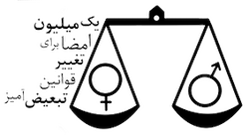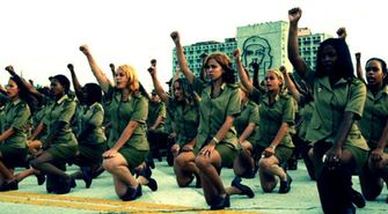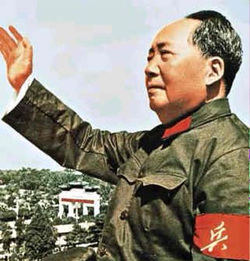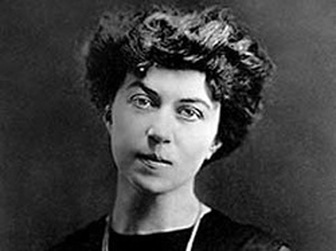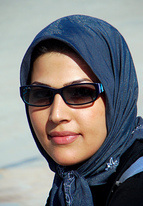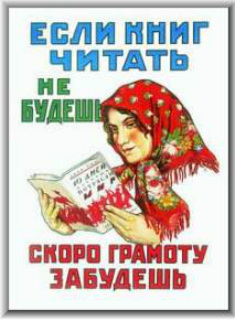AGMSPRITE
Yazmin Gooren & Pete Dauphin
ArtThe Change for Equality logo, part of the One Million Signatures campaign, which seeks to eradicate discriminatory laws against women in Iran, and thereby make their presence in the artistic world noticeable once again.
The impacts of 20th centuries’ revolutions vary from country to country. In Iran, the revolution had a negative effect on women. Very early on, they were prohibited any sort of artistic participation, or if not, other restrictions posed a problem. For example, the hijab was an impediment to performing arts seeing as it caused very slow movements by actresses which stripped them of emotion. CONT. on right
|
CONT. Additionally, women not being allowed to touch men made the depiction of romantic relationships seem less realistic, which was similar to the limitations placed upon female writers to describe love or the relationship between an unmarried man and woman, another factor reducing the quality of artistic work produced. In the realm of cinema, years passed before Iranian filmmakers succeed in dodging censorship and conveying love without physical expressions of desire. Meanwhile, female singers were banned from the radio, and the possession of any of their recordings made illegal and punishable by law. The situation in China was similar in many ways, seeing as artistic participation of Chinese women was for a long time limited to their ability to serve as art’s subject, appealing to the general public with beauty, poise, and often, silence. This has become less with the legal elimination of such aesthetic-preserving tactics as foot binding but the situation still isn’t good. Even though the contemporary art scene in China has been booming since the 90s, and made much money since then, there are next to female participants in that arena, making female art hard to come by, which is likely caused by the fact that schools in China have a strong tendency to split their subjects according to gender with boys pursuing sciences and girls pursuing arts. Meanwhile in Russia, women enjoyed different circumstances altogether. Even early on in the Communist Revolution, female artists were allowed to express themselves aptly, with Vitebsk and Kiev became important artistic centers, together with Moscow and Petrograd. From the end of the nineteenth century, when the first women painters appeared on the Russian artistic scene, female Russian art has been vacillating in between folk and avant-garde inspirations, bringing about many different styles, as well as many art patrons and gallery owners, art historians and art critics, as opposed to visual artists exclusively. The revolution in Cuba provided equally favorable circumstances for women, but generally enjoyed more limited exposure. However, it remained existent nonetheless, seeing as women have consistently received education in the arts since the Cuban revolution. Female singers are the most internationally recognized (think Gloria Estefan, La Lupe, Celia Cruz, etc) and known to nearly all of Hispanic descent and Spanish speaking abilities.
|
MilitaryThe impact of revolutions in the 20th century has been generally positive. In Iran, women were allowed to join the police and military forces during the revolution, though shortly thereafter General Dr. Madani, the Islamic Republic’s first Minister of Defense, attended a gathering of professors at the University of Kerman and said: “I have issued an order to exempt women from military service.” Currently, though, Iran claims that about 3 million women in its armed forces are “combat capable.” However, it is believed that these numbers are in fact much lower, as religious traditionalism prevents women from actively participating in war, though small numbers of female troops have been confirmed. Meanwhile in China, women increasingly infiltrated predominantly male environments, which included the police force and military. However, as with most gender-sensitive matters in China, women are still in the minority, and they are not given the same military duties as men.
|
Women of the CRAF show their unity and strength during one of the army's many training sessions during the actual revolution itself.
|
In fact, female recruits are currently asked to sing, dance or highlight other artistic abilities as part of the military’s selection process (see quote below). In Russia, after political rights were expanded for women, many began to join the Russian army, which led to many female combat units being assembled, as well. The Red Army at one point boasted about 50,000-70,000 women enlisted. In Cuba, women also became increasingly involved with the Cuban Revolutionary Armed Forces, which consists of ground forces, naval forces, air and air defence forces, and other paramilitary bodies, and has roughly 3 million women (ages 15 to 49) available for military service and nearly 2 million fit for said service, though a little less than half a million actually serve.
“China Daily reports that the PLA interview for women includes a 30-second self-introduction, a 2.5-minute Q&A, and a 2-minute talent show. The interview is scored on a 30-point scale, with “expression” worth up to 12 points, “impression” up to ten points, and the talent portion eight points...The talent test is a new requirement and applies only to female recruits, and officials insisted that it is necessary, though their various reasons were not entirely convincing. Lieutenant Colonel Ding Zhengquan, a recruiter in Beijing, told China Daily that the standards had been raised because there were relatively fewer openings for women than for men.”
SocietyMao Zedong: the controversial figure responsible for the generic improvement of women's conditions in China
|
The biggest impact the respective revolutions in Iran, China, Russia, and Cuba had on women pertained to their role in society, and the manner in which that role varied from country to country. In Iran, an Article was passed in the July of 1968 which stated that “cultural, health, medical and social services are also recognized as the holy duty of women. Performing these services will be mandatory for women who acquire a high school diploma or higher degrees.” These included cultural/educational services, as well as health/medical/government services, campaigns against illiteracy, and services for the public welfare. However, on March 6, 1979, this bill was already annulled, and the idea of an “ideal revolutionary woman” trained in tradition, limited to the house and motherly roles, religious and, segregated from men in public, was championed instead. The veiling of the head became mandatory, and a morality police emerged to make sure women were in compliance with these rules, with punishment including both public whippings and jail time. Most of the more serious pieces of anti-female legislation are more familiar to us all (men could once simply declare "I divorce you" three times to dissolve their marriages while women lost all right to sue for divorce; It takes the testimony of 2 women to equal the testimony of 1 man in court; Women accused of adultery have to prove their innocence, rather than the accuser proving their guilt, and if convicted they may be executed by stoning, etc.) but remain awful. Fortunately, women in Iran still have access to education, seeing as a result of the revolution, the economy went into recession, and women were forced out of the house to begin competing in business and the workplace. In China, Mao Zedong criminalized spousal abuse, foot binding, arranged marriage, and utilizing both concubines and prostitutes. The All-China Women’s Federation was also created, which promoted the idea of land and marriage reform rights for women. However, societal pressures, stemming from Confucian tradition, remained, and
|
women were continuously pressured into aborting female fetuses, seeing as the overpopulation of China has become a very large problem, the One Child policy was enacted, and boys were preferred due to their higher money-making-potential. This remains a problem today. In Russia, women also gained equal protection under the, which was mostly on account of Lenin, seeing as he was the first political leader in power to proclaim the equality of men and women. Also, since the Bolsheviks did not believe in any division among classes, including the division between men and women, they initially did not have any specific policies centered on women. But eventually came to advocate the "liberation of women and the transformation of the family." With reforming laws like the Code on Marriage, the Family, and Guardianship, women received equal rights over their property and earnings, divorce was both legalized and facilitated, marriage became a civil action among consenting adults, abortion became legal, maternity leave was mandated, women were no longer required to take their husbands' surnames, and women were mobilized as workers in Russia's drive to industrialization. However, a near-total return to the pre-revolution status quo occurred within a matter of years, mostly due to Stalin and the lower classes, though the generic situation did improve. Meanwhile in Cuba, changes were more lasting; prior to the revolution, many women were often forced to work in domestic positions. However, with the revolution came an increase in education and jobs for women, and organizations like the Federation of Cuban Women push for equal rights in Cuba, focused on issues directly affecting women, and started many literacy and health campaigns. As a result, women in Cuba are now highly educated, and dominate both the judicial and educational employment sectors of the nation, In addition, women also can easily obtain divorces, contraceptives, and abortions.
PoliticsFemale political involvement after the surge of revolutions during the 20th century mostly increased but to varied extents. In Iran, women fared better before the revolution than after it: they were allowed to work as envoys and members of diplomatic missions, which was a mostly a result of the fact that they were being trained in a university faculty that was linked to the Ministry of Foreign Affairs, as well as the Faculty of Law and Political science at the University of Tehran and other universities closely tied to Iranian consulates and embassies. Immediately after the revolution, however, this was all abolished. Most women previously involved in Iranian politics in any manner whatsoever were forced either into administrative positions or out of the field completely. The regime either purged women diplomats or transferred them to administrative sectors, and though stifled, many women continued their protests, sit-ins and demonstrations against the status quo for a long time.
Meanwhile in China, women were, as a result of the many social changes brought about by the Chinese Revolution, now allowed to pursue jobs in the governmental sector. However, they are currently still in the vast minority when it comes to actually holding positions within the Chinese government, which is heavily male-dominated. So a tremendous improvement, relatively speaking, but only a minor improvement, internationally speaking.
|
Alexandra Kollontai, the leader of the Zhenotdel division of the Communist Party, entertained a radical feminist agenda, and was instrumental in the improvement of conditions for women.
|
Russia was initially way more proactive than both Iran and China, setting up the Zhenotdel division of the Communist Party, which was led by a woman (Alexandra Kollontai) and pushed a strictly feminist agenda. Their goal was to not separate women issues but to combine women and men issues and create a larger socialist liberation movement. Under this provisional government, women earned the rights to vote, serve as attorneys, and equal rights in civil service. The Zhenotdel spread the news of the revolution and organized political education and literacy classes for working class women, equipped women with the skills to run day-care centers as well as medical clinics, and published newspapers and magazines aimed at a female audience though they were often opposed by common people (peasants) and male communists, which finally led to it being abolished by Stalin in 1930, seeing as he feared that the female liberation movement would detract from a political emphasis on industrial production. In following years, women still had to take on the burden of housework, child care, and paid employment, seeing as men were still the prevalent sex in Russian society, which may also be observed in the fact that women rarely achieved a top political leadership role in Russia, after the revolution. However, as was mentioned earlier, generic conditions have improved. In Cuba, meanwhile, the Federation of Cuban Women (FMC) was formed while the revolution was still in full swing and was recognized as a major political party, with the majority of Cuban women belonging to it. Many government positions are also held by women, as are judgeships.
|
A hijab worn by an Iranian woman
|
ReligionIn regards to traditional religious values, women’s rights movement in Communist countries did not uphold them. In Russia, China, and Cuba women were able to divorce. This did not coincide with the beliefs of Christianity, or in China’s case, Confucianism. An even further deviation from Christianity was giving the women the right to an abortion. These developments demonstrate that the women’s rights movement in Communist countries undermined some of the traditional religious beliefs.
In contrast, the Iranian Revolution did the exact opposite. Women were expected to adhere to strict Islamic beliefs. Women’s rights were reduced under the Sharia Law, and given a distinct role in society. Under the Sharia Law, women were no longer given equal control in regards to marriage and children. In addition to that, they were ordered by law to wear a veil in public places. |
Intellect
|
Following the revolutions in Russia, China, Cuba, and Iran women were able to expand their intellect. All these governments made education more accessible for women in some regard. In Russia, the Zhenotdel was established, which was a group that focused on women’s issues. They actively sought out to educate women by organizing classes that taught peasant and working-class women. In China, Mao desired equality between men and women. Mao put emphasis on education and included women into this. Following the Cuban Revolution women became were able to become educated. Campaigns were created to educate and create a literate society. Cuban women are able to receive a comprehensive education, go to universities, and become scientists, doctors, lawyers , politicians etc. Iran allowed for women to educate themselves too. Women in Iran are beginning to outnumber men at universities. However, this has faced opposition from conservative groups, who believe this causes imbalances between men and women.
“A people whose women fight alongside men – that people is invincible."
|
Russian propaganda encouraging women to read.
|
Economy
In communist countries, the revolutions’ treatment women greatly facilitated economic development, but also hindered it. In Russia, China, and Cuba, the Marxist belief of equality brought upon opportunities for women. They were no longer confined to domestic roles, and were able to enter the labor force. While in the labor force they were given equal pay for equal work. Women involved in the workforce in Russia rose from 250,000 to over one million following the revolution. Similarly, women in Cuba make up 46.7% of the workforce. With an increase in workers Russia was able to increase their production. Conversely, China admitting women into the workforce caused an issue; the economy was not able to absorb the huge workforce. However, following the non-communist Iranian Revolution women were excluded from the workforce, and encouraged into domestic roles.
Works Cited
"Artists: Russia and the Soviet Union | Jewish Women's Archive." Jewish Women's Archive. JWA, n.d. Web. 04 May 2013. <http://jwa.org/encyclopedia/article/artists-russia-and-soviet-union>.
"China’s Military Women Hold Up Half The Sky (And Dance, And Sing, And...)." China Real Time Report RSS. Wall Street Journal, n.d. Web. 03 May 2013. <http://blogs.wsj.com/chinarealtime/2009/11/30/chinas-military-women-hold-up-half-the-sky-and-dance-and-sing-and…/>.
Cotter, Holland. "China's Female Artists Quietly Emerge." The New York Times. The New York Times, 30 July 2008. Web. 05 May 2013. <http://www.nytimes.com/2008/07/30/arts/design/30arti.html?pagewanted=all>.
"Cuban Women Artists." Center for Cuban Studies. CCS, n.d. Web. 04 May 2013. <http://www.cubanartspace.net/womenart/women-art.php>.
Engel, Barbara Alpern (2004). Women in Russia, 1700–2000. Cambridge, U.K.: Cambridge University Press.Li, Yuhui. "Women's Movement and Change of Women's Status in China*." N.p., n.d. Web. 05 May 2013.
"What Was the Impact of Chinese Revolution on Women and Family?" Impact of Chinese Revolution on Women and Family. Preserve, n.d. Web. 02 May 2013. <http://www.preservearticles.com/2011090713165/what-was-the-impact-of-chinese-revolution-on-women-and-family.html>.
"Women, the Victims of the Iranian Revolution." A Forum on Human Rights and Democracy in Iran. Gozaar, n.d. Web. 02 May 2013. <http://www.gozaar.org/english/articles-en/Women-the-Victims-of-the-Iranian-Revolution.html>.
"China’s Military Women Hold Up Half The Sky (And Dance, And Sing, And...)." China Real Time Report RSS. Wall Street Journal, n.d. Web. 03 May 2013. <http://blogs.wsj.com/chinarealtime/2009/11/30/chinas-military-women-hold-up-half-the-sky-and-dance-and-sing-and…/>.
Cotter, Holland. "China's Female Artists Quietly Emerge." The New York Times. The New York Times, 30 July 2008. Web. 05 May 2013. <http://www.nytimes.com/2008/07/30/arts/design/30arti.html?pagewanted=all>.
"Cuban Women Artists." Center for Cuban Studies. CCS, n.d. Web. 04 May 2013. <http://www.cubanartspace.net/womenart/women-art.php>.
Engel, Barbara Alpern (2004). Women in Russia, 1700–2000. Cambridge, U.K.: Cambridge University Press.Li, Yuhui. "Women's Movement and Change of Women's Status in China*." N.p., n.d. Web. 05 May 2013.
"What Was the Impact of Chinese Revolution on Women and Family?" Impact of Chinese Revolution on Women and Family. Preserve, n.d. Web. 02 May 2013. <http://www.preservearticles.com/2011090713165/what-was-the-impact-of-chinese-revolution-on-women-and-family.html>.
"Women, the Victims of the Iranian Revolution." A Forum on Human Rights and Democracy in Iran. Gozaar, n.d. Web. 02 May 2013. <http://www.gozaar.org/english/articles-en/Women-the-Victims-of-the-Iranian-Revolution.html>.
